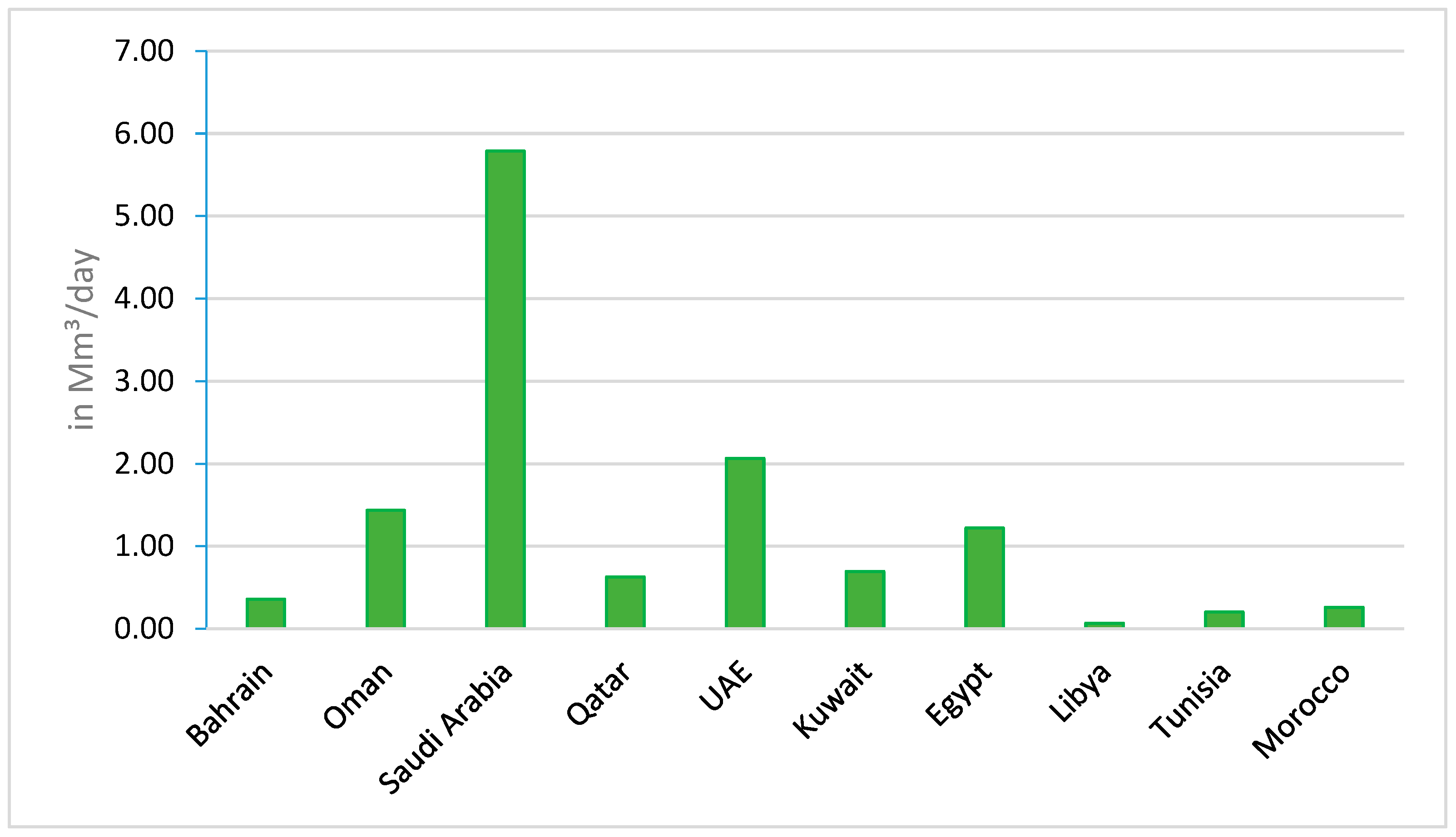Innovations in Solar-Powered Desalination: A Comprehensive Review of Sustainable Solutions for Water Scarcity in the Middle East and North Africa (MENA) Region
Abstract
:1. Introduction
2. Background
2.1. Overview of Membrane-Based Processes
2.2. Components of Seawater Desalination with RO Process
2.3. Challenges Associated with the RO Process
2.3.1. High Energy Consumption
2.3.2. Membrane Fouling
2.3.3. Environmental Challenges
2.3.4. Boron Removal
3. Reverse Osmosis Technology Dominance in the MENA Region
4. Contribution of MENA Countries to Solar-Driven RO Desalination Research
- −
- Advancements in materials: Keywords such as “nanofluid” (4 occurrences, APY = 2021.25) and “phase change materials” (6 occurrences, APY = 2021.33) indicate ongoing research aimed at enhancing thermal efficiency and energy storage capabilities. This could lead to more viable and cost-effective solar desalination systems.
- −
- Integration of CSP and solar chimney: Keywords like “concentrated solar power” (5 occurrences, APY = 2021.4) and “solar chimney” (4 occurrences, APY = 2021.5) suggest that these technologies will likely see increased integration into desalination systems. These technologies efficiently convert solar energy into thermal energy, thereby improving overall system efficiency.
- −
- Increased use of artificial intelligence (AI): Keywords such as “artificial intelligence” (5 occurrences, APY = 2023) and “decision making” (4 occurrences, APY = 2021) indicate a growing focus on developing intelligent systems for predictive maintenance, process optimization, and real-time decision-making in solar-powered desalination plants. For example, AI could optimize energy consumption based on variable solar irradiance.
5. Potential for Renewable Energies and Resources in the MENA Region
5.1. Solar Photovoltaics
5.2. Solar Thermal Energy
6. Advancements in Solar Energy-Driven RO Technology Deployment in the MENA Region
6.1. Solar Photovoltaic-Powered RO Systems
6.2. Solar Thermal-Powered RO Systems
7. Solar Desalination Challenges and Opportunities in MENA
7.1. Challenges in Solar-Powered RO Desalination in MENA
7.1.1. High Initial Investment Cost
7.1.2. Technical Complexities
- Optimizing energy capture and utilization: Developing systems capable of efficiently converting solar energy into electricity for desalination purposes is essential.
- Energy storage solutions: Implementing robust and efficient energy storage methods is critical for addressing fluctuations in solar radiation and meeting peak demand during periods of low sunlight.
- Reliability and durability: Equipment must be designed to function reliably and maintain its integrity under harsh environmental conditions, including extreme temperatures, humidity, dust, and salt corrosion.
- Variability in solar irradiance and weather patterns: System design and operation must account for variations in solar radiation levels and weather patterns, which influence the availability and intensity of solar energy.
7.1.3. Limited Funding for Research and Development
7.1.4. Lack of Expertise
7.2. Opportunities for Navigating the Challenges of RO Desalination Plants in the MENA Region
7.2.1. Technology Optimization and Innovation
7.2.2. Government Support, Financial Incentives, and Investment
7.2.3. Regional Collaboration and Knowledge Sharing
7.2.4. Investment in Education, Training, and Capacity Building
7.2.5. Promotion of Local Manufacturing and Innovation
8. Conclusions
Author Contributions
Funding
Data Availability Statement
Acknowledgments
Conflicts of Interest
References
- Boretti, A.; Rosa, L. Reassessing the Projections of the World Water Development Report. npj Clean Water 2019, 2, 15. [Google Scholar] [CrossRef]
- Tashtoush, B.; Alyahya, W.; Al Ghadi, M.; Al-Omari, J.; Morosuk, T. Renewable Energy Integration in Water Desalination: State-of-the-Art Review and Comparative Analysis. Appl. Energy 2023, 352, 121950. [Google Scholar] [CrossRef]
- Central California area Office Water Facts—Worldwide Water Supply|ARWEC| CCAO|Area Offices|California-Great Basin|Bureau of Reclamation. Available online: https://www.usbr.gov/mp/arwec/water-facts-ww-water-sup.html (accessed on 4 January 2024).
- Maftouh, A.; El Fatni, O.; Bouzekri, S.; Bahaj, T.; Kacimi, I.; El Hajjaji, S.; Malik, A. Solar Desalination: Current Applications and Future Potential in MENA Region—A Case Study. J. Sustain. Dev. Energy Water Environ. Syst. 2023, 11, 1100437. [Google Scholar] [CrossRef]
- Mazzoni, A.; Zaccagni, S. Status of Water Resources and Human Health in the Middle East and North Africa Region: An Integrated Perspective; Elsevier: Amsterdam, The Netherlands, 2019. [Google Scholar]
- Waha, K.; Krummenauer, L.; Adams, S.; Aich, V.; Baarsch, F.; Coumou, D.; Fader, M.; Hoff, H.; Jobbins, G.; Marcus, R.; et al. Climate Change Impacts in the Middle East and Northern Africa (MENA) Region and Their Implications for Vulnerable Population Groups. Reg. Environ. Chang. 2017, 17, 1623–1638. [Google Scholar] [CrossRef]
- Moustakbal, J. Water Resources and Climate Change in MENA Region. Available online: http://www.cadtm.org/Water-resources-and-climate-change (accessed on 18 March 2024).
- Bahri, A. Water Reuse in Middle Eastern and North African Countries. In Water Reuse: An International Survey of Current Practice, Issues and Needs; IWA Publishing: London, UK, 2008; pp. 27–47. [Google Scholar]
- FAO; AQUASTAT Food and Agriculture Organization of the United Nations. AQUASTAT Database, Data for 2008–2014; FAO: Rome, Italy, 2018. [Google Scholar]
- Zekri, S. Water Policies in MENA Countries; Springer: Cham, Switzerland, 2020. [Google Scholar] [CrossRef]
- Zekri, S. An Overview of the Water Sector in MENA Region; Global Issues in Water Policy; Springer: Berlin/Heidelberg, Germany, 2020; pp. 1–17. [Google Scholar]
- Khan, M.A.M.; Rehman, S.; Al-Sulaiman, F.A. A Hybrid Renewable Energy System as a Potential Energy Source for Water Desalination Using Reverse Osmosis: A Review. Renew. Sustain. Energy Rev. 2018, 97, 456–477. [Google Scholar] [CrossRef]
- Lawal, D.U.; Qasem, N.A.A. Humidification-Dehumidification Desalination Systems Driven by Thermal-Based Renewable and Low-Grade Energy Sources: A Critical Review. Renew. Sustain. Energy Rev. 2020, 125, 109817. [Google Scholar] [CrossRef]
- Jones, E.; Qadir, M.; van Vliet, M.T.H.; Smakhtin, V.; Kang, S. The State of Desalination and Brine Production: A Global Outlook. Sci. Total Environ. 2019, 657, 1343–1356. [Google Scholar] [CrossRef] [PubMed]
- Malaeb, L.; Ayoub, G.M. Reverse Osmosis Technology for Water Treatment: State of the Art Review. Desalination 2011, 267, 1–8. [Google Scholar] [CrossRef]
- Shahzad, M.W.; Burhan, M.; Ang, L.; Ng, K.C. Energy-Water-Environment Nexus Underpinning Future Desalination Sustainability. Desalination 2017, 413, 52–64. [Google Scholar] [CrossRef]
- Ibrahim, A.-J.; Shirazi, N.S. Energy-Water-Environment Nexus and the Transition Towards a Circular Economy: The Case of Qatar. Circ. Econ. Sustain. 2021, 1, 835–850. [Google Scholar] [CrossRef]
- Wan, R.; Ni, M. Sustainable Water–Energy–Environment Nexus. Environ. Sci. Pollut. Res. 2021, 28, 40049–40052. [Google Scholar] [CrossRef] [PubMed]
- Anand, B.; Shankar, R.; Murugavelh, S.; Rivera, W.; Midhun Prasad, K.; Nagarajan, R. A Review on Solar Photovoltaic Thermal Integrated Desalination Technologies. Renew. Sustain. Energy Rev. 2021, 141, 110787. [Google Scholar] [CrossRef]
- Eke, J.; Yusuf, A.; Giwa, A.; Sodiq, A. The Global Status of Desalination: An Assessment of Current Desalination Technologies, Plants and Capacity. Desalination 2020, 495, 114633. [Google Scholar] [CrossRef]
- Shalaby, S.M.; Sharshir, S.W.; Kabeel, A.E.; Kandeal, A.W.; Abosheiasha, H.F.; Abdelgaied, M.; Hamed, M.H.; Yang, N. Reverse Osmosis Desalination Systems Powered by Solar Energy: Preheating Techniques and Brine Disposal Challenges—A Detailed Review. Energy Convers. Manag. 2022, 251, 114971. [Google Scholar] [CrossRef]
- Boubakri, A.; Al-Tahar Bouguecha, S.; Hafiane, A. FO–MD Integrated Process for Nitrate Removal from Contaminated Groundwater Using Seawater as Draw Solution to Supply Clean Water for Rural Communities. Sep. Purif. Technol. 2022, 298, 121621. [Google Scholar] [CrossRef]
- Goh, P.S.; Zulhairun, A.K.; Ismail, A.F.; Hilal, N. Contemporary Antibiofouling Modifications of Reverse Osmosis Desalination Membrane: A Review. Desalination 2019, 468, 114072. [Google Scholar] [CrossRef]
- Sayed, E.T.; Olabi, A.G.; Elsaid, K.; Al Radi, M.; Alqadi, R.; Ali Abdelkareem, M. Recent Progress in Renewable Energy Based-Desalination in the Middle East and North Africa MENA Region. J. Adv. Res. 2023, 48, 125–156. [Google Scholar] [CrossRef]
- Byrne, P.; Fournaison, L.; Delahaye, A.; Ait Oumeziane, Y.; Serres, L.; Loulergue, P.; Szymczyk, A.; Mugnier, D.; Malaval, J.-L.; Bourdais, R.; et al. A Review on the Coupling of Cooling, Desalination and Solar Photovoltaic Systems. Renew. Sustain. Energy Rev. 2015, 47, 703–717. [Google Scholar] [CrossRef]
- Alawad, S.M.; Ben Mansour, R.; Al-Sulaiman, F.A.; Rehman, S. Renewable Energy Systems for Water Desalination Applications: A Comprehensive Review. Energy Convers. Manag. 2023, 286, 117035. [Google Scholar] [CrossRef]
- Alkaisi, A.; Mossad, R.; Sharifian-Barforoush, A. A Review of the Water Desalination Systems Integrated with Renewable Energy. Energy Procedia 2017, 110, 268–274. [Google Scholar] [CrossRef]
- Al-Obaidi, M.A.; Zubo, R.H.A.; Rashid, F.L.; Dakkama, H.J.; Abd-Alhameed, R.; Mujtaba, I.M. Evaluation of Solar Energy Powered Seawater Desalination Processes: A Review. Energies 2022, 15, 6562. [Google Scholar] [CrossRef]
- Ahmed, F.E.; Hashaikeh, R.; Hilal, N. Solar Powered Desalination—Technology, Energy and Future Outlook. Desalination 2019, 453, 54–76. [Google Scholar] [CrossRef]
- Rahimi, B.; Shirvani, H.; Alamolhoda, A.A.; Farhadi, F.; Karimi, M. A Feasibility Study of Solar-Powered Reverse Osmosis Processes. Desalination 2021, 500, 114885. [Google Scholar] [CrossRef]
- Van der Bruggen, B. Microfiltration, Ultrafiltration, Nanofiltration, Reverse Osmosis, and Forward Osmosis; Elsevier: Amsterdam, The Netherlands, 2018; ISBN 9780128134849. [Google Scholar]
- Zhang, X.; Cahill, D.G.; Coronell, O.; Mariñas, B.J. Absorption of Water in the Active Layer of Reverse Osmosis Membranes. J. Memb. Sci. 2009, 331, 143–151. [Google Scholar] [CrossRef]
- Najdawi, F.; Neptune, K. Optimizing Reverse Osmosis Membrane Parameters through the Use of the Solution-Diffusion Model: A Review. Engineering 2022, 14, 9–32. [Google Scholar] [CrossRef]
- Lee, K.P.; Arnot, T.C.; Mattia, D. A Review of Reverse Osmosis Membrane Materials for Desalination—Development to Date and Future Potential. J. Memb. Sci. 2011, 370, 1–22. [Google Scholar] [CrossRef]
- Altmann, T.; Buijs, P.J.; Farinha, A.S.F.; Borges, V.R.P.; Farhat, N.M.; Vrouwenvelder, J.S.; Das, R. Seawater Reverse Osmosis Performance Decline Caused by Short-Term Elevated Feed Water Temperature. Membranes 2022, 12, 792. [Google Scholar] [CrossRef]
- Elgharbi, S.; Boubakri, A.; Bouguecha, S.; Chemingui, S.; Alanazy, H.D.; Hafiane, A. Unlocking Groundwater Desalination Potential for Agriculture with Fertilizer Drawn Forward Osmosis: Prediction and Performance Optimization via RSM and ANN. Environ. Sci. Pollut. Res. 2024. [Google Scholar] [CrossRef]
- Lim, Y.J.; Goh, K.; Kurihara, M.; Wang, R. Seawater Desalination by Reverse Osmosis: Current Development and Future Challenges in Membrane Fabrication—A Review. J. Memb. Sci. 2021, 629, 119292. [Google Scholar] [CrossRef]
- Sanna, A.; Buchspies, B.; Ernst, M.; Kaltschmitt, M. Decentralized Brackish Water Reverse Osmosis Desalination Plant Based on PV and Pumped Storage—Technical Analysis. Desalination 2021, 516, 115232. [Google Scholar] [CrossRef]
- Saleem, M.W.; Abbas, A.; Asim, M.; Uddin, G.M.; Chaudhary, T.N.; Ullah, A. Design and Cost Estimation of Solar Powered Reverse Osmosis Desalination System. Adv. Mech. Eng. 2021, 13, 16878140211029090. [Google Scholar] [CrossRef]
- Stover, R.L. Seawater Reverse Osmosis with Isobaric Energy Recovery Devices. Desalination 2007, 203, 168–175. [Google Scholar] [CrossRef]
- Hailemariam, R.H.; Woo, Y.C.; Damtie, M.M.; Kim, B.C.; Park, K.-D.; Choi, J.-S. Reverse Osmosis Membrane Fabrication and Modification Technologies and Future Trends: A Review. Adv. Colloid Interface Sci. 2020, 276, 102100. [Google Scholar] [CrossRef] [PubMed]
- Karabelas, A.J.; Koutsou, C.P.; Kostoglou, M.; Sioutopoulos, D.C. Analysis of Specific Energy Consumption in Reverse Osmosis Desalination Processes. Desalination 2018, 431, 15–21. [Google Scholar] [CrossRef]
- Kavitha, J.; Rajalakshmi, M.; Phani, A.R.; Padaki, M. Pretreatment Processes for Seawater Reverse Osmosis Desalination Systems—A Review. J. Water Process Eng. 2019, 32, 100926. [Google Scholar] [CrossRef]
- Shrivastava, A.; Rosenberg, S.; Peery, M. Energy Efficiency Breakdown of Reverse Osmosis and Its Implications on Future Innovation Roadmap for Desalination. Desalination 2015, 368, 181–192. [Google Scholar] [CrossRef]
- Nassrullah, H.; Anis, S.F.; Hashaikeh, R.; Hilal, N. Energy for Desalination: A State-of-the-Art Review. Desalination 2020, 491, 114569. [Google Scholar] [CrossRef]
- Voutchkov, N. Energy Use for Membrane Seawater Desalination—Current Status and Trends. Desalination 2018, 431, 2–14. [Google Scholar] [CrossRef]
- Boubakri, A.; Bouguecha, S. Diagnostic and Membrane Autopsy of Djerba Island Desalination Station. Desalination 2008, 220, 403–411. [Google Scholar] [CrossRef]
- Qasim, M.; Badrelzaman, M.; Darwish, N.N.; Darwish, N.A.; Hilal, N. Reverse Osmosis Desalination: A State-of-the-Art Review. Desalination 2019, 459, 59–104. [Google Scholar] [CrossRef]
- Tawalbeh, M.; Al Mojjly, A.; Al-Othman, A.; Hilal, N. Membrane Separation as a Pre-Treatment Process for Oily Saline Water. Desalination 2018, 447, 182–202. [Google Scholar] [CrossRef]
- Weinrich, L.; Haas, C.N.; LeChevallier, M.W. Recent Advances in Measuring and Modeling Reverse Osmosis Membrane Fouling in Seawater Desalination: A Review. J. Water Reuse Desalin. 2013, 3, 85–101. [Google Scholar] [CrossRef]
- Jiang, S.; Li, Y.; Ladewig, B.P. A Review of Reverse Osmosis Membrane Fouling and Control Strategies. Sci. Total Environ. 2017, 595, 567–583. [Google Scholar] [CrossRef] [PubMed]
- Du, X.; Wang, Y.; Leslie, G.; Li, G.; Liang, H. Shear Stress in a Pressure-Driven Membrane System and Its Impact on Membrane Fouling from a Hydrodynamic Condition Perspective: A Review. J. Chem. Technol. Biotechnol. 2017, 92, 463–478. [Google Scholar] [CrossRef]
- Tawalbeh, M.; Qalyoubi, L.; Al-Othman, A.; Qasim, M.; Shirazi, M. Insights on the Development of Enhanced Antifouling Reverse Osmosis Membranes: Industrial Applications and Challenges. Desalination 2023, 553, 116460. [Google Scholar] [CrossRef]
- Uppu, A.; Chaudhuri, A.; Prasad Das, S. Numerical Modeling of Particulate Fouling and Cake-Enhanced Concentration Polarization in Roto-Dynamic Reverse Osmosis Filtration Systems. Desalination 2019, 468, 114053. [Google Scholar] [CrossRef]
- Vitzilaiou, E.; Stoica, I.M.; Knøchel, S. Microbial Biofilm Communities on Reverse Osmosis Membranes in Whey Water Processing before and after Cleaning. J. Memb. Sci. 2019, 587, 117174. [Google Scholar] [CrossRef]
- Hoek, E.M.V.; Weigand, T.M.; Edalat, A. Reverse Osmosis Membrane Biofouling: Causes, Consequences and Countermeasures. npj Clean Water 2022, 5, 45. [Google Scholar] [CrossRef]
- Elsaid, K.; Sayed, E.T.; Abdelkareem, M.A.; Mahmoud, M.S.; Ramadan, M.; Olabi, A.G. Environmental Impact of Emerging Desalination Technologies: A Preliminary Evaluation. J. Environ. Chem. Eng. 2020, 8, 104099. [Google Scholar] [CrossRef]
- Panagopoulos, A.; Haralambous, K.-J. Environmental Impacts of Desalination and Brine Treatment—Challenges and Mitigation Measures. Mar. Pollut. Bull. 2020, 161, 111773. [Google Scholar] [CrossRef]
- Panagopoulos, A.; Haralambous, K.-J.; Loizidou, M. Desalination Brine Disposal Methods and Treatment Technologies—A Review. Sci. Total Environ. 2019, 693, 133545. [Google Scholar] [CrossRef]
- Belkin, N.; Rahav, E.; Elifantz, H.; Kress, N.; Berman-Frank, I. The Effect of Coagulants and Antiscalants Discharged with Seawater Desalination Brines on Coastal Microbial Communities: A Laboratory and in Situ Study from the Southeastern Mediterranean. Water Res. 2017, 110, 321–331. [Google Scholar] [CrossRef] [PubMed]
- Cambridge, M.L.; Zavala-Perez, A.; Cawthray, G.R.; Mondon, J.; Kendrick, G.A. Effects of High Salinity from Desalination Brine on Growth, Photosynthesis, Water Relations and Osmolyte Concentrations of Seagrass Posidonia Australis. Mar. Pollut. Bull. 2017, 115, 252–260. [Google Scholar] [CrossRef] [PubMed]
- Maliva, R.G.; Missimer, T.M. Arid Lands Water Evaluation and Management; Springer: Berlin/Heidelberg, Germany, 2012. [Google Scholar]
- Kim, J.; Park, K.; Hong, S. Application of Two-Stage Reverse Osmosis System for Desalination of High-Salinity and High-Temperature Seawater with Improved Stability and Performance. Desalination 2020, 492, 114645. [Google Scholar] [CrossRef]
- Abualtayef, M.; Al-Najjar, H.; Mogheir, Y.; Seif, A.K. Numerical Modeling of Brine Disposal from Gaza Central Seawater Desalination Plant. Arab. J. Geosci. 2016, 9, 572. [Google Scholar] [CrossRef]
- Xiong, R.; Wei, C. Current Status and Technology Trends of Zero Liquid Discharge at Coal Chemical Industry in China. J. Water Process Eng. 2017, 19, 346–351. [Google Scholar] [CrossRef]
- Cui, P.; Qian, Y.; Yang, S. New Water Treatment Index System toward Zero Liquid Discharge for Sustainable Coal Chemical Processes. ACS Sustain. Chem. Eng. 2018, 6, 1370–1378. [Google Scholar] [CrossRef]
- Tufa, R.A.; Curcio, E.; Brauns, E.; van Baak, W.; Fontananova, E.; Di Profio, G. Membrane Distillation and Reverse Electrodialysis for Near-Zero Liquid Discharge and Low Energy Seawater Desalination. J. Memb. Sci. 2015, 496, 325–333. [Google Scholar] [CrossRef]
- Morgante, C.; Lopez, J.; Cortina, J.L.; Tamburini, A. New Generation of Commercial Nanofiltration Membranes for Seawater/Brine Mining: Experimental Evaluation and Modelling of Membrane Selectivity for Major and Trace Elements. Sep. Purif. Technol. 2024, 340, 126758. [Google Scholar] [CrossRef]
- Zuo, J.; Chow, C.A.; Dumée, L.F.; Prince, A.J. A Zero-Brine Discharge Seawater Desalination Using a Pilot-Scale Membrane Distillation System Integrated with Crystallizer. Membranes 2022, 12, 799. [Google Scholar] [CrossRef]
- Boubakri, A.; Bouguecha, S.A.-T.; Dhaouadi, I.; Hafiane, A. Effect of Operating Parameters on Boron Removal from Seawater Using Membrane Distillation Process. Desalination 2015, 373, 86–93. [Google Scholar] [CrossRef]
- Najid, N.; Kouzbour, S.; Ruiz-García, A.; Fellaou, S.; Gourich, B.; Stiriba, Y. Comparison Analysis of Different Technologies for the Removal of Boron from Seawater: A Review. J. Environ. Chem. Eng. 2021, 9, 105133. [Google Scholar] [CrossRef]
- Mansour, R. Ben Modeling and Optimization of Salt and Boron Removal in Reverse Osmosis System. Desalination 2023, 562, 116699. [Google Scholar] [CrossRef]
- Wang, S.; Bing, S.; Zhang, H.; Zhou, Y.; Zhang, L.; Gao, C. Surface Engineering Design of Polyamide Membranes for Enhanced Boron Removal in Seawater Desalination. J. Memb. Sci. 2022, 651, 120425. [Google Scholar] [CrossRef]
- Kabay, N.; Bryjak, M. Boron Removal from Seawater Using Reverse Osmosis Integrated Processes. In Boron Separation Processes; Elsevier B.V: Amsterdam, The Netherlands, 2015. [Google Scholar]
- Fajardo-Diaz, J.L.; Takeuchi, K.; Morelos-Gomez, A.; Cruz-Silva, R.; Yamanaka, A.; Tejima, S.; Izu, K.; Saito, S.; Ito, I.; Maeda, J.; et al. Enhancing Boron Rejection in Low-Pressure Reverse Osmosis Systems Using a Cellulose Fiber–Carbon Nanotube Nanocomposite Polyamide Membrane: A Study on Chemical Structure and Surface Morphology. J. Memb. Sci. 2023, 679, 121691. [Google Scholar] [CrossRef]
- Liu, X.; Xu, C.; Chen, P.; Li, K.; Zhou, Q.; Ye, M.; Zhang, L.; Lu, Y. Advances in Technologies for Boron Removal from Water: A Comprehensive Review. Int. J. Environ. Res. Public Health 2022, 19, 10671. [Google Scholar] [CrossRef] [PubMed]
- Fadaei, A. A Comparison of Techniques of Boron Removal from Water and Wastewater. J. Environ. Sci. Sustain. Dev. 2022, 5, 404–435. [Google Scholar]
- Bin Darwish, N.; Alkhudhiri, A.; AlAlawi, A.; AlRomaih, H.; Hilal, N. Experimental Investigation of Forward Osmosis Process for Boron Removal from Water. J. Water Process Eng. 2020, 38, 101570. [Google Scholar] [CrossRef]
- Shocron, A.N.; Uwayid, R.; Guyes, E.N.; Dykstra, J.E.; Suss, M.E. Order-of-Magnitude Enhancement in Boron Removal by Membrane-Free Capacitive Deionization. Chem. Eng. J. 2023, 466, 142722. [Google Scholar] [CrossRef]
- Global Water Intelligence. IDA Desalination Yearbook; International Desalination Association (IDA): São Paulo, Brazil, 2017. [Google Scholar]
- Kharraz, D.J.E. Desalination as an Alternative to Alleviate Water Scarcity and a Climate Change Adaptation Option in the MENA Region; Konrad-Adenauer-Stiftung: Washington, DC, USA, 2020. [Google Scholar]
- International Desalination Association. The IDA Water Security Handbook 2019–2020; International Desalination Association: Danvers, MA, USA, 2019. [Google Scholar]
- Ben Jebli, M.; Farhani, S.; Guesmi, K. Renewable Energy, CO2 Emissions and Value Added: Empirical Evidence from Countries with Different Income Levels. Struct. Chang. Econ. Dyn. 2020, 53, 402–410. [Google Scholar] [CrossRef]
- IRENA. Renewable Energy Statistics 2022; International Renewable Energy Agency IRENA: Masdar City, United Arab Emirates, 2022; ISBN 1523152478. [Google Scholar]
- Nakat, G. Renewable Energy in MENA: Embracing Transition Amidst Oil Affluence. Available online: https://www.greenpeace.org/mena/en/renewable-energy-in-mena-ghiwa/ (accessed on 17 March 2024).
- IRENA. Renewable Energy Policies in a Time of Transition; IRENA: Masdar City, United Arab Emirates, 2018. [Google Scholar]
- Irena, I.R. Renewable Energy Outlook Egypt; International Renewable Energy Agency: Masdar City, Abu Dhabi, 2018. [Google Scholar]
- Saudi Arabia Saudi Green Initiative Forum. 2022. Available online: https://www.greeninitiatives.gov.sa/sgi-forum (accessed on 23 February 2024).
- Sayed, E.T.; Wilberforce, T.; Elsaid, K.; Rabaia, M.K.H.; Abdelkareem, M.A.; Chae, K.-J.; Olabi, A.G. A Critical Review on Environmental Impacts of Renewable Energy Systems and Mitigation Strategies: Wind, Hydro, Biomass and Geothermal. Sci. Total Environ. 2021, 766, 144505. [Google Scholar] [CrossRef]
- Dobrotkova, Z.; Surana, K.; Audinet, P. The Price of Solar Energy: Comparing Competitive Auctions for Utility-Scale Solar PV in Developing Countries. Energy Policy 2018, 118, 133–148. [Google Scholar] [CrossRef]
- Wilson, G.M.; Al-Jassim, M.; Metzger, W.K.; Glunz, S.W.; Verlinden, P.; Xiong, G.; Mansfield, L.M.; Stanbery, B.J.; Zhu, K.; Yan, Y.; et al. The 2020 Photovoltaic Technologies Roadmap. J. Phys. D Appl. Phys. 2020, 53, 493001. [Google Scholar] [CrossRef]
- Kumar, N.M.; Chopra, S.S.; de Oliveira, A.K.V.; Ahmed, H.; Vaezi, S.; Madukanya, U.E.; Castañón, J.M. Chapter 3—Solar PV Module Technologies. In Photovoltaic Solar Energy Conversion; Gorjian, S., Shukla, A.B.T.-P.S.E.C., Eds.; Academic Press: Cambridge, MA, USA, 2020; pp. 51–78. ISBN 978-0-12-819610-6. [Google Scholar]
- Liu, Z.; Guo, Z.; Chen, Q.; Song, C.; Shang, W.; Yuan, M.; Zhang, H. A Review of Data-Driven Smart Building-Integrated Photovoltaic Systems: Challenges and Objectives. Energy 2023, 263, 126082. [Google Scholar] [CrossRef]
- Fathy, A.; Elaziz, M.A.; Sayed, E.T.; Olabi, A.G.; Rezk, H. Optimal Parameter Identification of Triple-Junction Photovoltaic Panel Based on Enhanced Moth Search Algorithm. Energy 2019, 188, 116025. [Google Scholar] [CrossRef]
- Shubbak, M.H. Advances in Solar Photovoltaics: Technology Review and Patent Trends. Renew. Sustain. Energy Rev. 2019, 115, 109383. [Google Scholar] [CrossRef]
- SOLARGIS Solar Resource Maps of Middle East and North Africa. 2022. Available online: https://solargis.com/maps-and-gis-data/download/middleeast-and-north-africa (accessed on 19 January 2024).
- Alghoul, M.A.; Poovanaesvaran, P.; Mohammed, M.H.; Fadhil, A.M.; Muftah, A.F.; Alkilani, M.M.; Sopian, K. Design and Experimental Performance of Brackish Water Reverse Osmosis Desalination Unit Powered by 2 KW Photovoltaic System. Renew. Energy 2016, 93, 101–114. [Google Scholar] [CrossRef]
- Jones, M.A.; Odeh, I.; Haddad, M.; Mohammad, A.H.; Quinn, J.C. Economic Analysis of Photovoltaic (PV) Powered Water Pumping and Desalination without Energy Storage for Agriculture. Desalination 2016, 387, 35–45. [Google Scholar] [CrossRef]
- Kumarasamy, S.; Narasimhan, S.; Narasimhan, S. Optimal Operation of Battery-Less Solar Powered Reverse Osmosis Plant for Desalination. Desalination 2015, 375, 89–99. [Google Scholar] [CrossRef]
- Monnot, M.; Carvajal, G.D.M.; Laborie, S.; Cabassud, C.; Lebrun, R. Integrated Approach in Eco-Design Strategy for Small RO Desalination Plants Powered by Photovoltaic Energy. Desalination 2018, 435, 246–258. [Google Scholar] [CrossRef]
- Ajiwiguna, T.A.; Lee, G.-R.; Lim, B.-J.; Cho, S.-H.; Park, C.-D. Optimization of Battery-Less PV-RO System with Seasonal Water Storage Tank. Desalination 2021, 503, 114934. [Google Scholar] [CrossRef]
- Ghafoor, A.; Ahmed, T.; Munir, A.; Arslan, C.; Ahmad, S.A. Techno-Economic Feasibility of Solar Based Desalination through Reverse Osmosis. Desalination 2020, 485, 114464. [Google Scholar] [CrossRef]
- Hamdan, H.; Saidy, M.; Alameddine, I.; Al-Hindi, M. The Feasibility of Solar-Powered Small-Scale Brackish Water Desalination Units in a Coastal Aquifer Prone to Saltwater Intrusion: A Comparison between Electrodialysis Reversal and Reverse Osmosis. J. Environ. Manag. 2021, 290, 112604. [Google Scholar] [CrossRef] [PubMed]
- Kettani, M.; Bandelier, P. Techno-Economic Assessment of Solar Energy Coupling with Large-Scale Desalination Plant: The Case of Morocco. Desalination 2020, 494, 114627. [Google Scholar] [CrossRef] [PubMed]
- Maleki, A.; Pourfayaz, F.; Ahmadi, M.H. Design of a Cost-Effective Wind/Photovoltaic/Hydrogen Energy System for Supplying a Desalination Unit by a Heuristic Approach. Sol. Energy 2016, 139, 666–675. [Google Scholar] [CrossRef]
- Mohammadi, K.; Saghafifar, M.; Ellingwood, K.; Powell, K. Hybrid Concentrated Solar Power (CSP)-Desalination Systems: A Review. Desalination 2019, 468, 114083. [Google Scholar] [CrossRef]
- Sharon, H.; Reddy, K.S. A Review of Solar Energy Driven Desalination Technologies. Renew. Sustain. Energy Rev. 2015, 41, 1080–1118. [Google Scholar] [CrossRef]
- Okampo, E.J.; Nwulu, N. Optimisation of Renewable Energy Powered Reverse Osmosis Desalination Systems: A State-of-the-Art Review. Renew. Sustain. Energy Rev. 2021, 140, 110712. [Google Scholar] [CrossRef]
- Gude, V.G.; Nirmalakhandan, N.; Deng, S.; Maganti, A. Low Temperature Desalination Using Solar Collectors Augmented by Thermal Energy Storage. Appl. Energy 2012, 91, 466–474. [Google Scholar] [CrossRef]
- Moossa, B.; Trivedi, P.; Saleem, H.; Zaidi, S.J. Desalination in the GCC Countries—A Review. J. Clean. Prod. 2022, 357, 131717. [Google Scholar] [CrossRef]
- Salcedo, R.; Antipova, E.; Boer, D.; Jiménez, L.; Guillén-Gosálbez, G. Multi-Objective Optimization of Solar Rankine Cycles Coupled with Reverse Osmosis Desalination Considering Economic and Life Cycle Environmental Concerns. Desalination 2012, 286, 358–371. [Google Scholar] [CrossRef]
- Delgado-Torres, A.M.; García-Rodríguez, L. Design Recommendations for Solar Organic Rankine Cycle (ORC)–Powered Reverse Osmosis (RO) Desalination. Renew. Sustain. Energy Rev. 2012, 16, 44–53. [Google Scholar] [CrossRef]
- Geng, D.; Cui, J.; Fan, L. Performance Investigation of a Reverse Osmosis Desalination System Powered by Solar Dish-Stirling Engine. Energy Rep. 2021, 7, 3844–3856. [Google Scholar] [CrossRef]
- Makkeh, S.A.; Ahmadi, A.; Esmaeilion, F.; Ehyaei, M.A. Energy, Exergy and Exergoeconomic Optimization of a Cogeneration System Integrated with Parabolic Trough Collector-Wind Turbine with Desalination. J. Clean. Prod. 2020, 273, 123122. [Google Scholar] [CrossRef]
- Le Quesne, W.J.F.; Fernand, L.; Ali, T.S.; Andres, O.; Antonpoulou, M.; Burt, J.A.; Dougherty, W.W.; Edson, P.J.; El Kharraz, J.; Glavan, J.; et al. Is the Development of Desalination Compatible with Sustainable Development of the Arabian Gulf? Mar. Pollut. Bull. 2021, 173, 112940. [Google Scholar] [CrossRef]
- Maftouh, A.; El Fatni, O.; Bouzekri, S.; Rajabi, F.; Sillanpää, M.; Butt, M.H. Economic Feasibility of Solar-Powered Reverse Osmosis Water Desalination: A Comparative Systemic Review. Environ. Sci. Pollut. Res. 2023, 30, 2341–2354. [Google Scholar] [CrossRef] [PubMed]
- El Azhar, F.; Tahaikt, M.; Zouhri, N.; Zdeg, A.; Hafsi, M.; Tahri, K.; Bari, H.; Taky, M.; Elamrani, M.; Elmidaoui, A. Remineralization of Reverse Osmosis (RO)-Desalted Water for a Moroccan Desalination Plant: Optimization and Cost Evaluation of the Lime Saturator Post. Desalination 2012, 300, 46–50. [Google Scholar] [CrossRef]
- Ennasri, H.; Drighil, A.; Adhiri, R.; Fahli, A.; Moussetad, M. Design and Simulation of a Solar Energy System for Desalination of Brackish Water. Environ. Clim. Technol. 2019, 23, 257–276. [Google Scholar] [CrossRef]
- Zidouri, H. Desalination of Morocco and Presentation of Design and Operation of the Laayoune Seawater Reverse Osmosis Plant. Desalination 2000, 131, 137–145. [Google Scholar] [CrossRef]
- Fthenakis, V.; Atia, A.A.; Morin, O.; Bkayrat, R.; Sinha, P. New Prospects for PV Powered Water Desalination Plants: Case Studies in Saudi Arabia. Prog. Photovolt. Res. Appl. 2016, 24, 543–550. [Google Scholar] [CrossRef]
- Alsheghri, A.; Sharief, S.A.; Rabbani, S.; Aitzhan, N.Z. Design and Cost Analysis of a Solar Photovoltaic Powered Reverse Osmosis Plant for Masdar Institute. Energy Procedia 2015, 75, 319–324. [Google Scholar] [CrossRef]
- Abdallah, S.; Abu-Hilal, M.; Mohsen, M.S. Performance of a Photovoltaic Powered Reverse Osmosis System under Local Climatic Conditions. Desalination 2005, 183, 95–104. [Google Scholar] [CrossRef]
- Al Suleimani, Z.; Nair, V.R. Desalination by Solar-Powered Reverse Osmosis in a Remote Area of the Sultanate of Oman. Appl. Energy 2000, 65, 367–380. [Google Scholar] [CrossRef]
- Rezk, H.; Sayed, E.T.; Al-Dhaifallah, M.; Obaid, M.; El-Sayed, A.H.M.; Abdelkareem, M.A.; Olabi, A.G. Fuel Cell as an Effective Energy Storage in Reverse Osmosis Desalination Plant Powered by Photovoltaic System. Energy 2019, 175, 423–433. [Google Scholar] [CrossRef]
- Al-Addous, M.; Jaradat, M.; Bdour, M.; Dalala, Z.; Wellmann, J. Combined Concentrated Solar Power Plant with Low-Temperature Multi-Effect Distillation. Energy Explor. Exploit. 2020, 38, 1831–1853. [Google Scholar] [CrossRef]
- Fathi Nassar, Y.; Yassin Alsadi, S. Assessment of Solar Energy Potential in Gaza Strip-Palestine. Sustain. Energy Technol. Assess. 2019, 31, 318–328. [Google Scholar] [CrossRef]
- Reif, J.H.; Alhalabi, W. Solar-Thermal Powered Desalination: Its Significant Challenges and Potential. Renew. Sustain. Energy Rev. 2015, 48, 152–165. [Google Scholar] [CrossRef]
- Shatat, M.; Worall, M.; Riffat, S. Opportunities for Solar Water Desalination Worldwide: Review. Sustain. Cities Soc. 2013, 9, 67–80. [Google Scholar] [CrossRef]
- Palenzuela, P.; Zaragoza, G.; Alarcón-Padilla, D.C.; Guillén, E.; Ibarra, M.; Blanco, J. Assessment of Different Configurations for Combined Parabolic-Trough (PT) Solar Power and Desalination Plants in Arid Regions. Energy 2011, 36, 4950–4958. [Google Scholar] [CrossRef]
- Pugsley, A.; Zacharopoulos, A.; Mondol, J.D.; Smyth, M. Global Applicability of Solar Desalination. Renew. Energy 2016, 88, 200–219. [Google Scholar] [CrossRef]
- Manolakos, D.; Kosmadakis, G.; Kyritsis, S.; Papadakis, G. On Site Experimental Evaluation of a Low-Temperature Solar Organic Rankine Cycle System for RO Desalination. Sol. Energy 2009, 83, 646–656. [Google Scholar] [CrossRef]
- Ibarra, M.; Rovira, A.; Alarcón-Padilla, D.C.; Zaragoza, G.; Blanco, J. Performance of a 5 KWe Solar-Only Organic Rankine Unit Coupled to a Reverse Osmosis Plant. Energy Procedia 2014, 49, 2251–2260. [Google Scholar] [CrossRef]
- Nafey, A.S.; Sharaf, M.A. Combined Solar Organic Rankine Cycle with Reverse Osmosis Desalination Process: Energy, Exergy, and Cost Evaluations. Renew. Energy 2010, 35, 2571–2580. [Google Scholar] [CrossRef]
- Li, C.; Kosmadakis, G.; Manolakos, D.; Stefanakos, E.; Papadakis, G.; Goswami, D.Y. Performance Investigation of Concentrating Solar Collectors Coupled with a Transcritical Organic Rankine Cycle for Power and Seawater Desalination Co-Generation. Desalination 2013, 318, 107–117. [Google Scholar] [CrossRef]
- Atanasovska, A. Solar Desalination: A Promising Solution for the Future of Water in MENA. Available online: https://water.fanack.com/publications/desalination/ (accessed on 25 January 2024).
- Kaya, A.; Tok, M.E.; Koc, M. A Levelized Cost Analysis for Solar-Energy-Powered Sea Water Desalination in The Emirate of Abu Dhabi. Sustainability 2019, 11, 1691. [Google Scholar] [CrossRef]
- Filippini, G.; Al-Obaidi, M.A.; Manenti, F.; Mujtaba, I.M. Design and Economic Evaluation of Solar-Powered Hybrid Multi Effect and Reverse Osmosis System for Seawater Desalination. Desalination 2019, 465, 114–125. [Google Scholar] [CrossRef]
- Al-Addous, M.; Bdour, M.; Alnaief, M.; Rabaiah, S.; Schweimanns, N. Water Resources in Jordan: A Review of Current Challenges and Future Opportunities. Water 2023, 15, 3729. [Google Scholar] [CrossRef]
- Oxford Business Group the Middle East Is at The Forefront of Low-Carbon Desalination Technology. Available online: https://oilprice.com/Energy/Energy-General/The-Middle-East-Is-At-The-Forefront-Of-Low-Carbon-Desalination-Technology.html (accessed on 18 February 2024).
- Hua, W.S.; Xu, H.J.; Xie, W.H. Review on Adsorption Materials and System Configurations of the Adsorption Desalination Applications. Appl. Therm. Eng. 2022, 204, 117958. [Google Scholar] [CrossRef]
- Shaikh, J.S.; Ismail, S. A Review on Recent Technological Advancements in Humidification Dehumidification (HDH) Desalination. J. Environ. Chem. Eng. 2022, 10, 108890. [Google Scholar] [CrossRef]


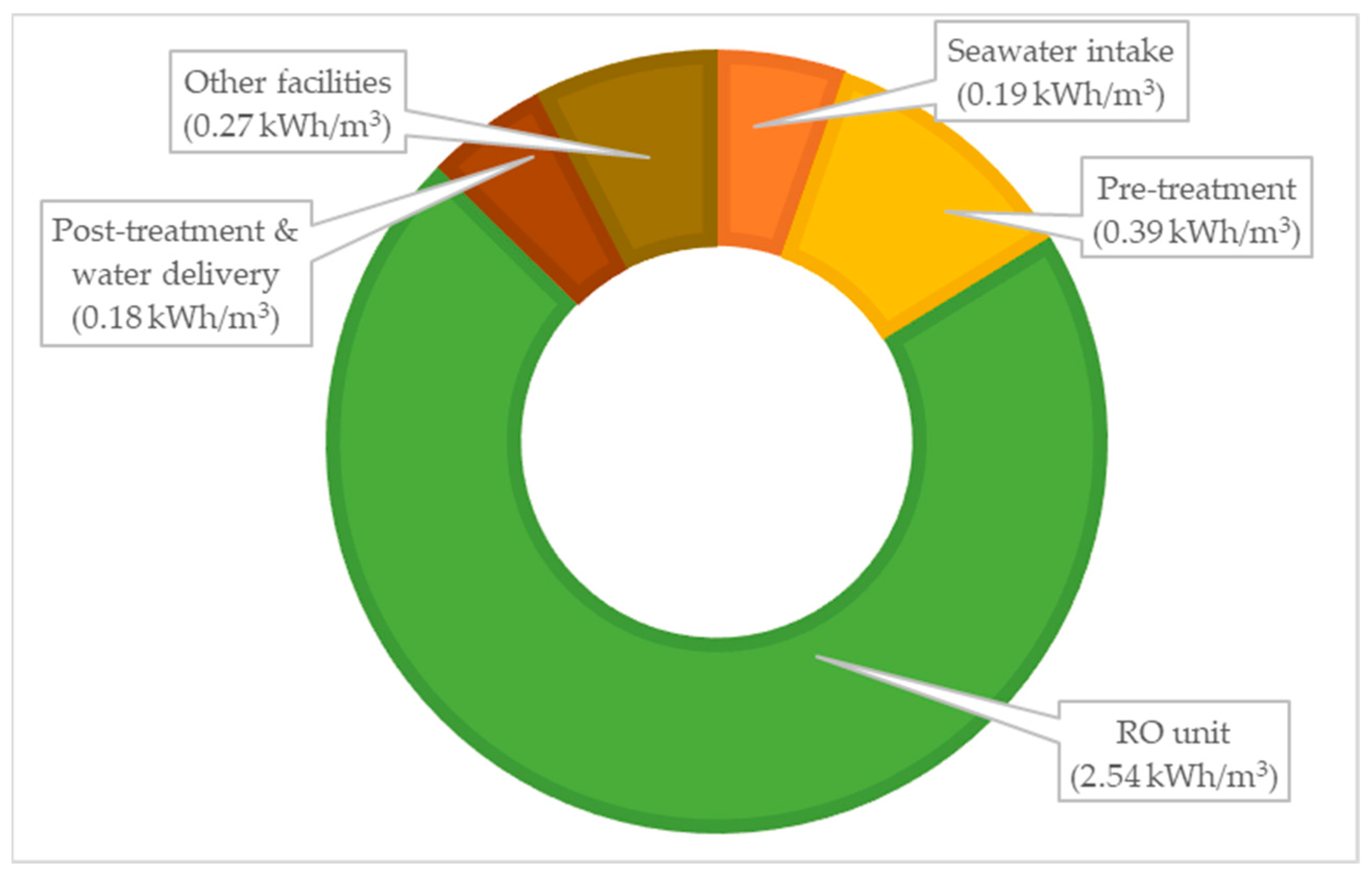
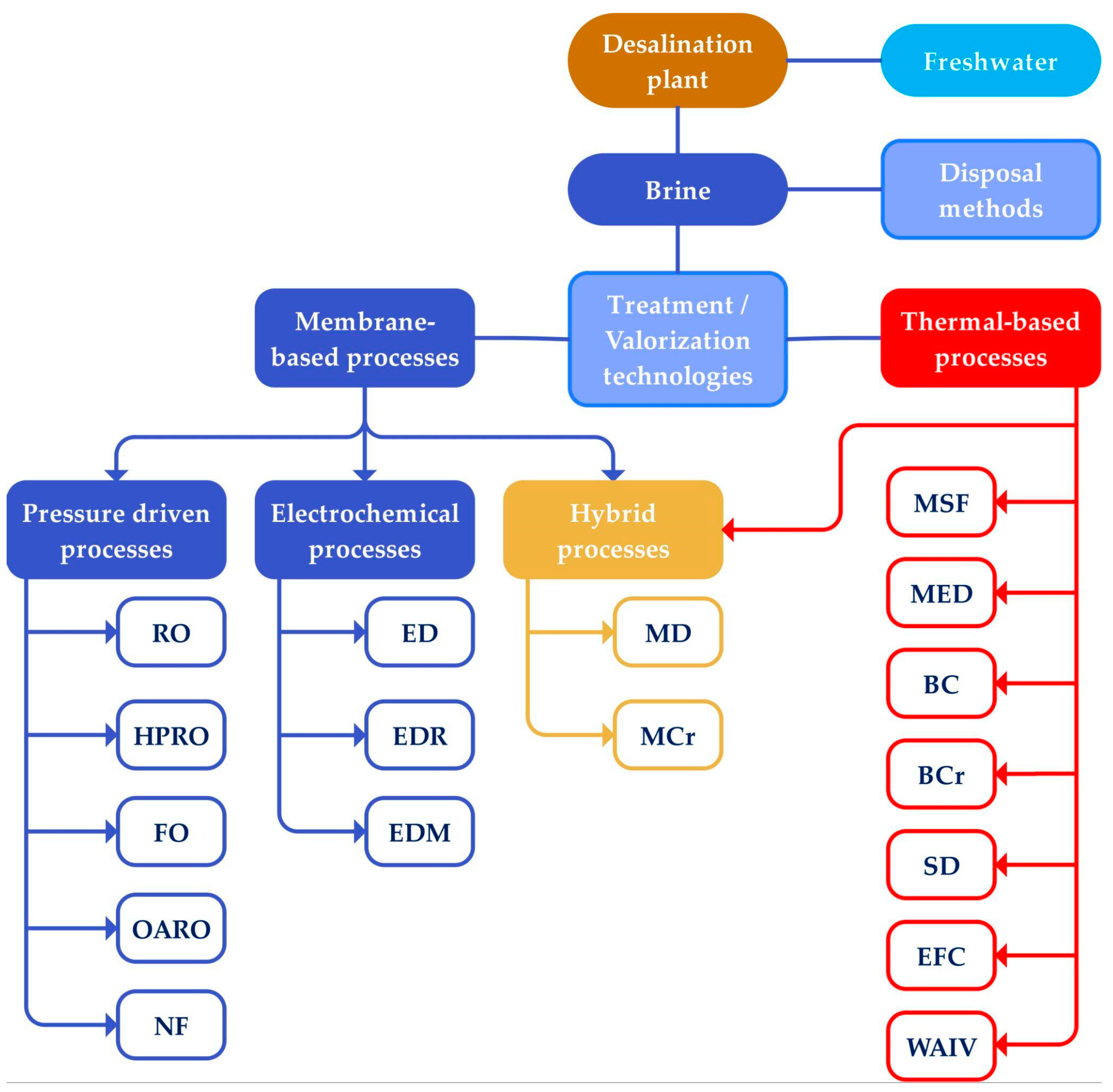
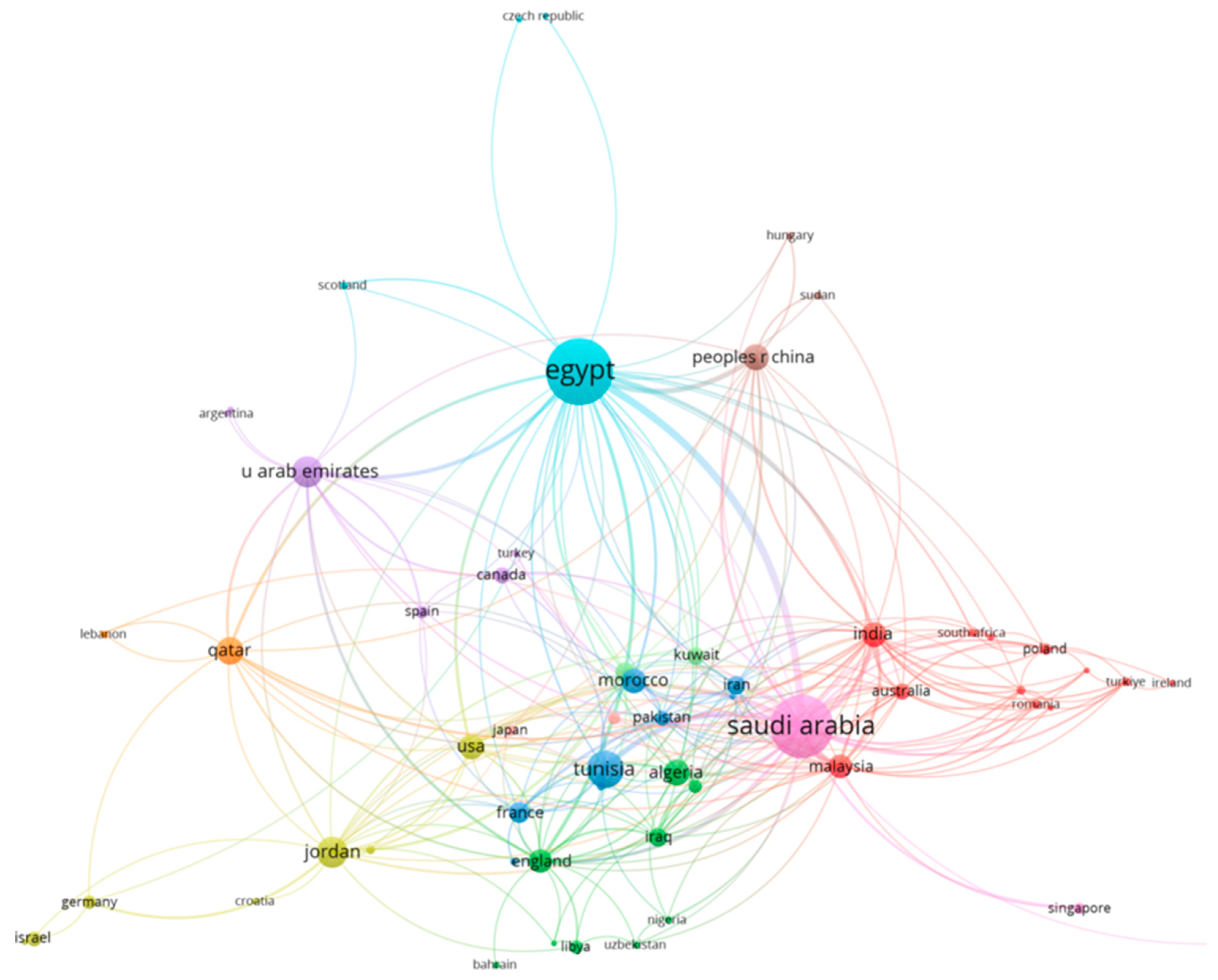

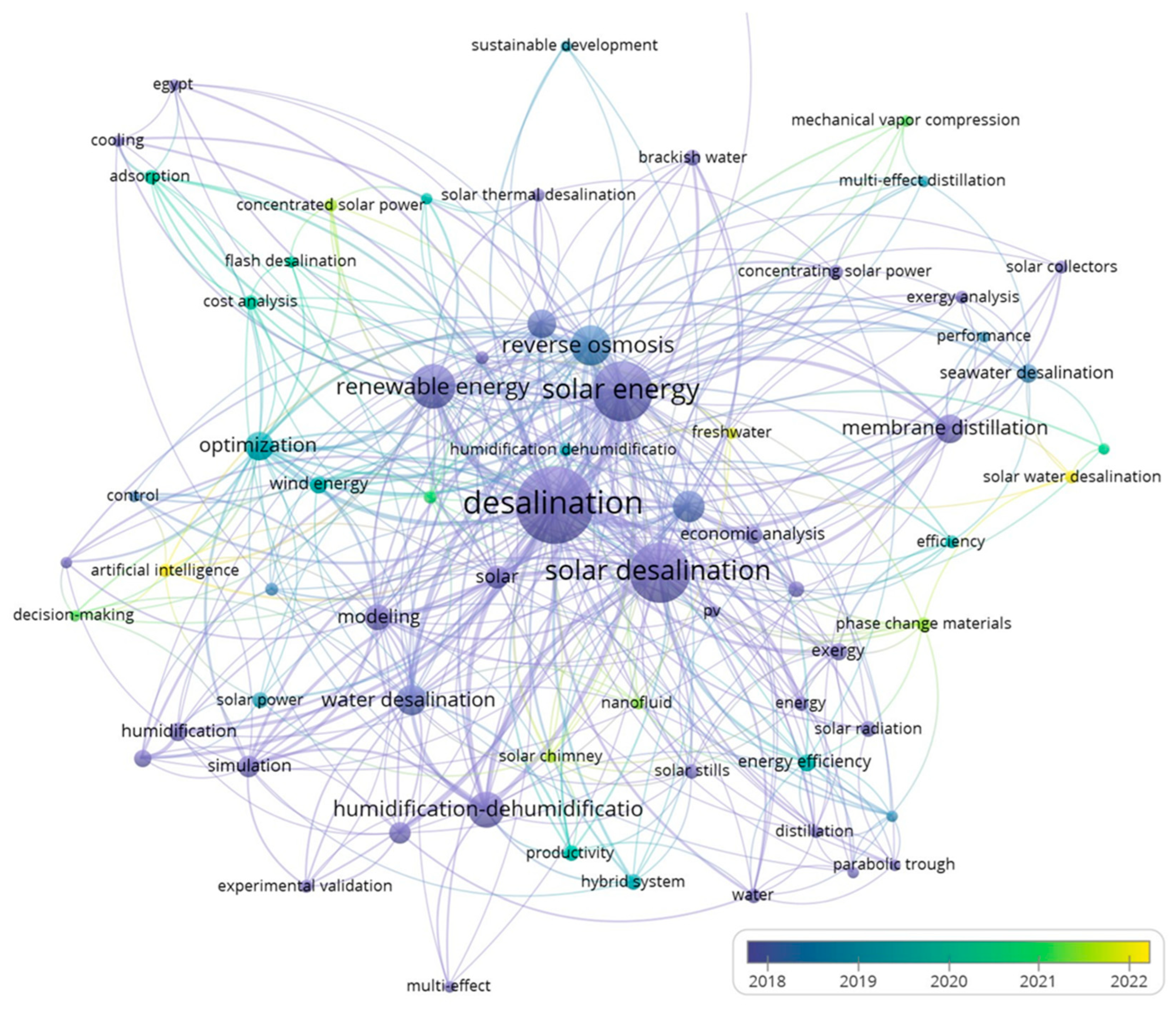
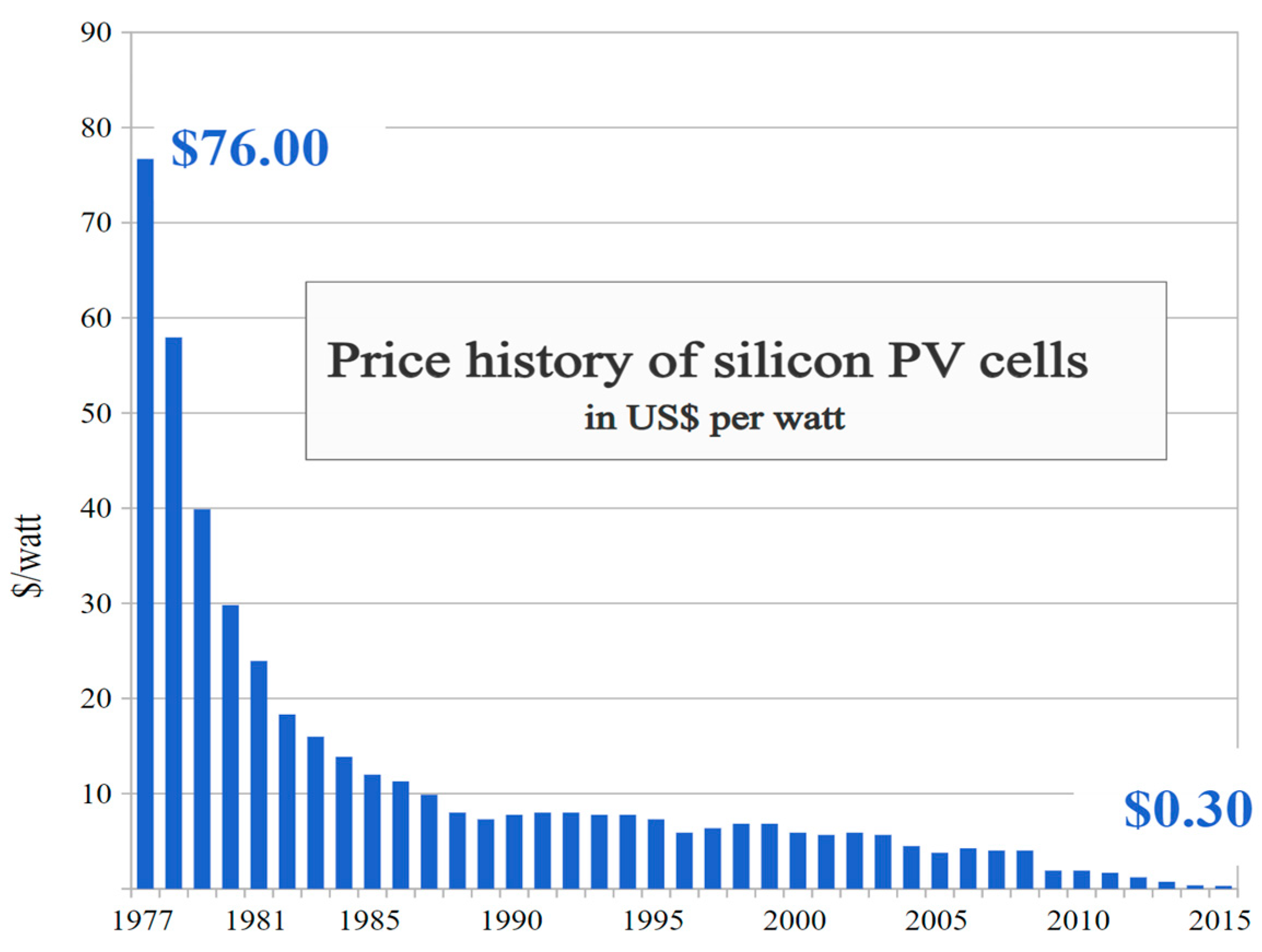
| Desalination Process | Driving Force | Working Principle |
|---|---|---|
| MSF | Thermal energy | Evaporation and condensation, natural water cycle |
| MED | Thermal energy | Evaporation and condensation in multiple stages |
| HDH | Thermal energy | Evaporation and condensation in separate chambers |
| MD | Thermal energy | Transfer of vapor molecules through a microporous hydrophobic membrane |
| Solar Distillation | Solar thermal energy | Evaporation and condensation, relying on natural solar radiation |
| Freezing | Thermal energy | Freezing and separation of water from salt in saline solutions |
| RO | Mechanical (pressure) | Separation of water molecules from salts through semi-permeable membranes |
| NF | Mechanical (pressure) | Similar to RO but with slightly larger pore sizes in the membrane for partial salt removal |
| PAO | Mechanical (pressure difference) | Separation of water from salts across a semi-permeable membrane using osmotic pressure |
| CDI | Electrical (potential difference) | Attraction and removal of ions from saline water using electrical potential |
| ED | Electrical (ion-selective membranes) | Separation of ions from saline water using electrical potential gradients |
| Location | Capacity (m3/d) | Feedwater | Operation Year | Cost (USD) |
|---|---|---|---|---|
| Umm al Quwain IWP, UAE | 681,900 | Seawater | 2020 | 250 M |
| Rabigh 3 IWP, KSA | 600,000 | Seawater | 2021 | - |
| Khobar 2 replacement SWRO, KSA | 600,000 | Seawater | 2021 | 650 M |
| Taweelah IWP, UAE | 909,200 | Seawater | 2022 | 840.5 M |
| Rabigh, KSA | 600,000 | Seawater | 2022 | - |
| Jubail 3b IWP, KSA | 600,000 | Seawater | 2022 | 3 bn |
| Jubail 3a IWP, KSA | 600,000 | Seawater | 2022 | 3 bn |
| Shoaiba 6 IWP, KSA | 600,000 | Seawater | 2029 | - |
| Hassyan SWRO, UAE | 545,520 | Seawater | Planned | - |
| Haradh BWRO, KSA | 800,000 | Brackish water or inland water | Planned | - |
Disclaimer/Publisher’s Note: The statements, opinions and data contained in all publications are solely those of the individual author(s) and contributor(s) and not of MDPI and/or the editor(s). MDPI and/or the editor(s) disclaim responsibility for any injury to people or property resulting from any ideas, methods, instructions or products referred to in the content. |
© 2024 by the authors. Licensee MDPI, Basel, Switzerland. This article is an open access article distributed under the terms and conditions of the Creative Commons Attribution (CC BY) license (https://creativecommons.org/licenses/by/4.0/).
Share and Cite
Al-Addous, M.; Bdour, M.; Rabaiah, S.; Boubakri, A.; Schweimanns, N.; Barbana, N.; Wellmann, J. Innovations in Solar-Powered Desalination: A Comprehensive Review of Sustainable Solutions for Water Scarcity in the Middle East and North Africa (MENA) Region. Water 2024, 16, 1877. https://doi.org/10.3390/w16131877
Al-Addous M, Bdour M, Rabaiah S, Boubakri A, Schweimanns N, Barbana N, Wellmann J. Innovations in Solar-Powered Desalination: A Comprehensive Review of Sustainable Solutions for Water Scarcity in the Middle East and North Africa (MENA) Region. Water. 2024; 16(13):1877. https://doi.org/10.3390/w16131877
Chicago/Turabian StyleAl-Addous, Mohammad, Mathhar Bdour, Shatha Rabaiah, Ali Boubakri, Norman Schweimanns, Nesrine Barbana, and Johannes Wellmann. 2024. "Innovations in Solar-Powered Desalination: A Comprehensive Review of Sustainable Solutions for Water Scarcity in the Middle East and North Africa (MENA) Region" Water 16, no. 13: 1877. https://doi.org/10.3390/w16131877






